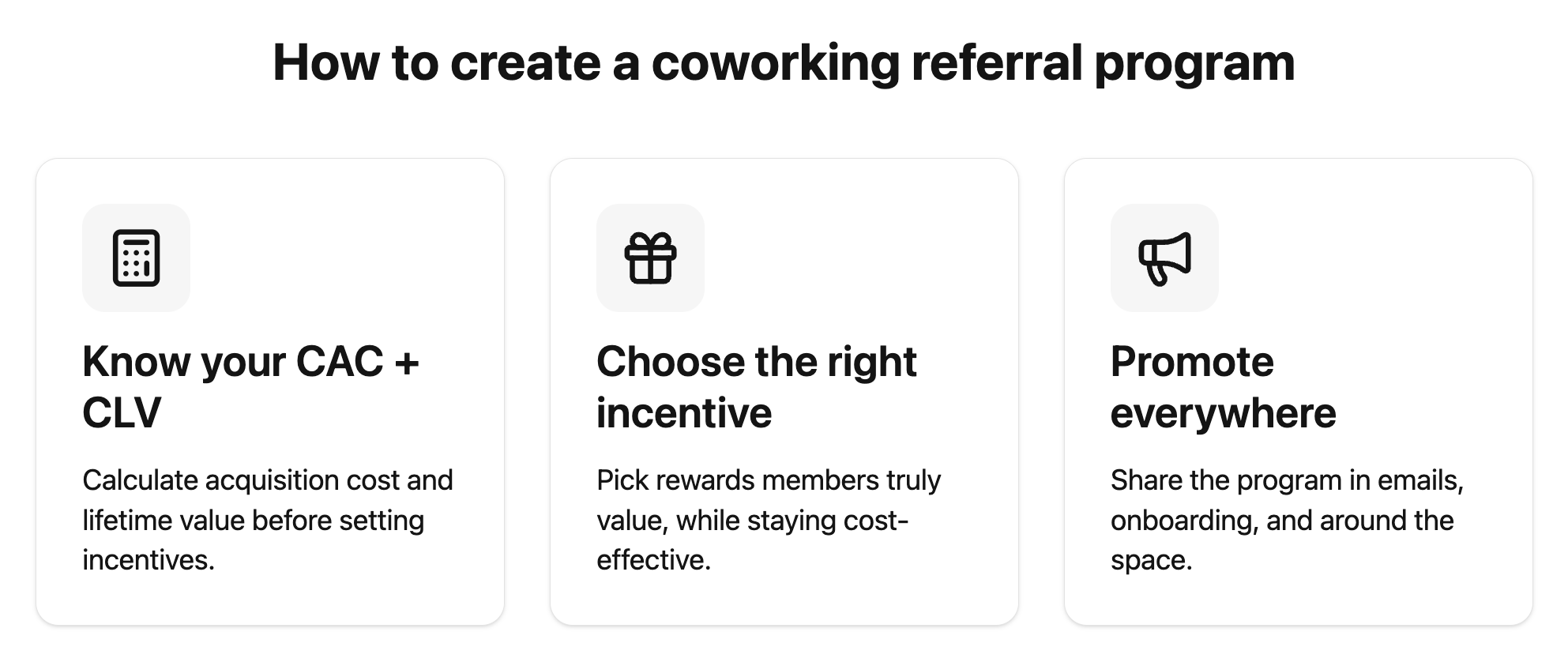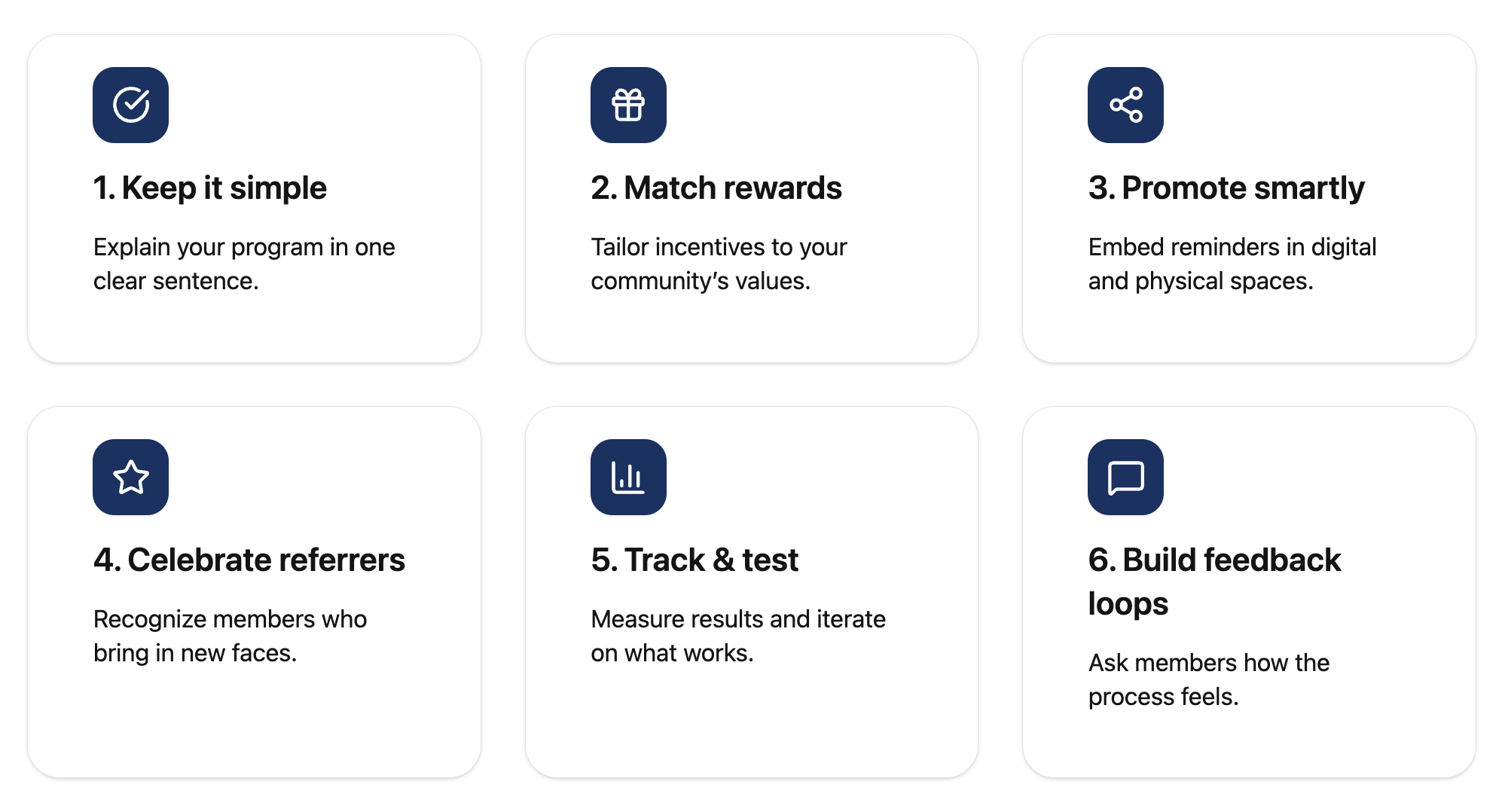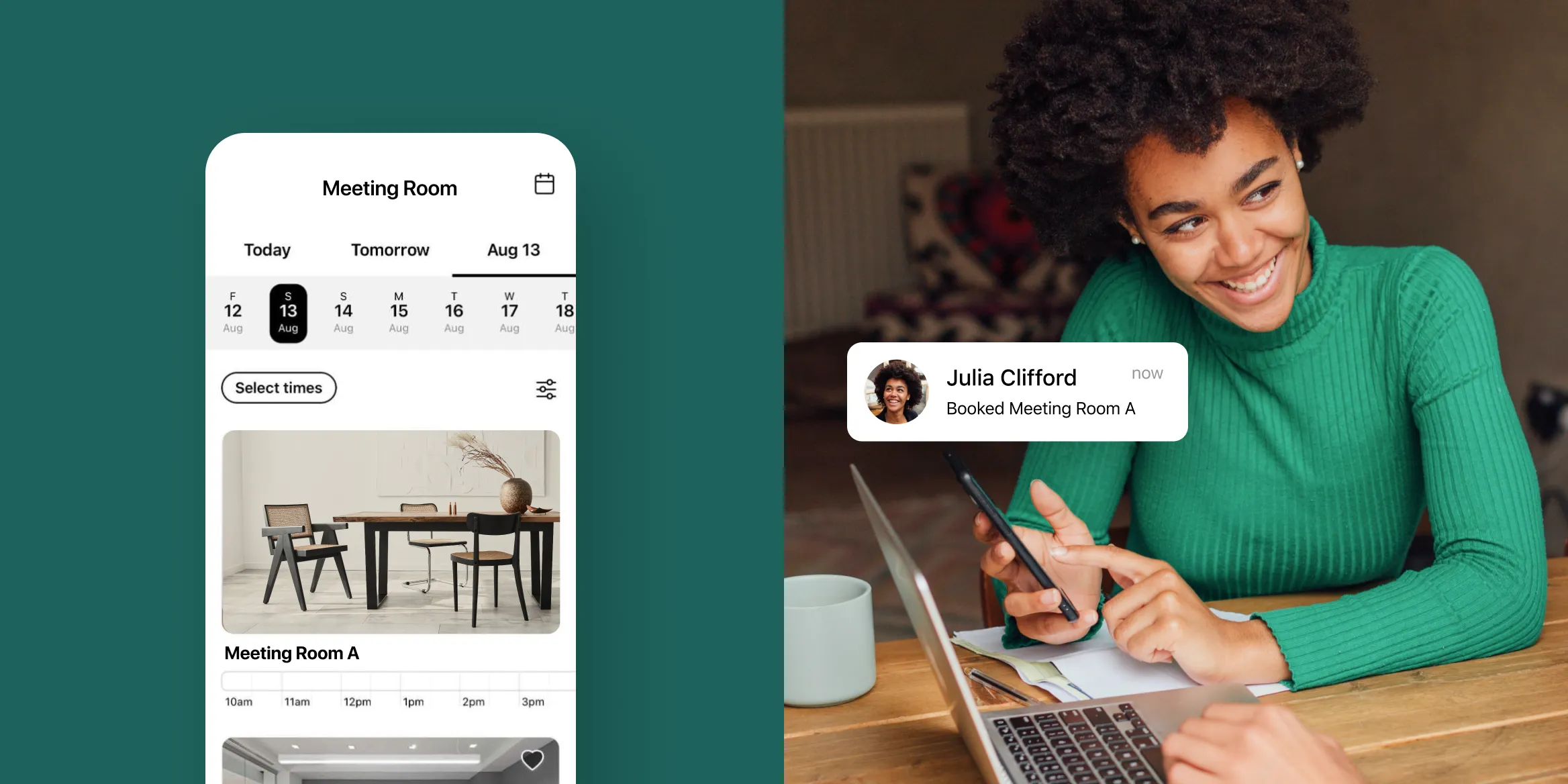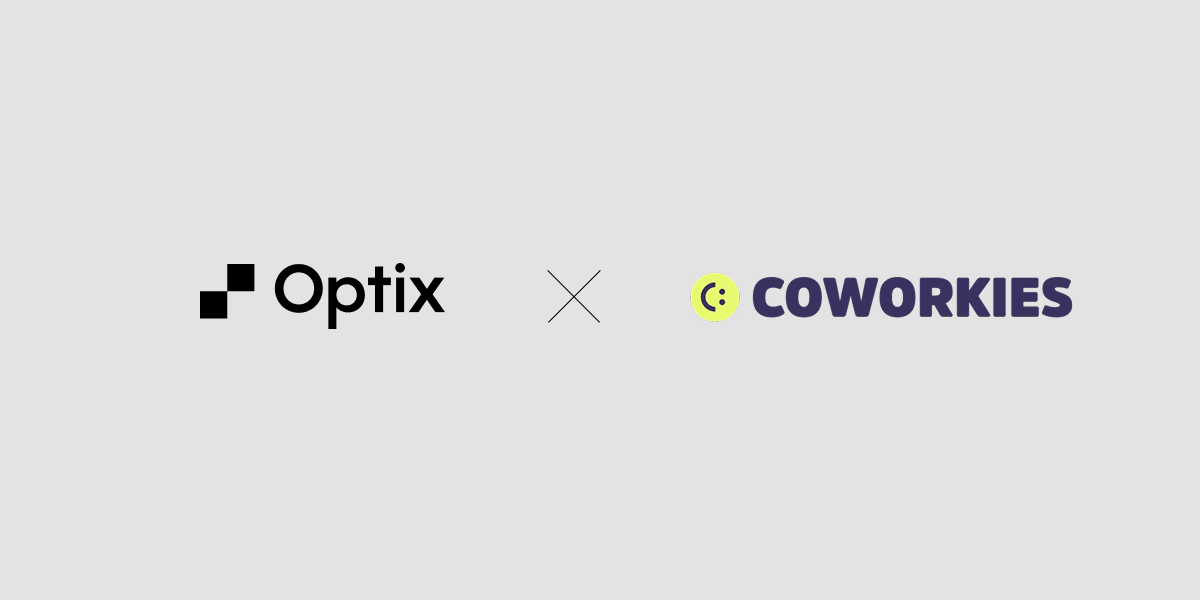
TL;DR
- A coworking referral program is an initiative that rewards existing members for bringing new members into your space
- An effective referral program needs to provide value to your members and be profitable fir your business
- When creating a program, you’ll want to ensure you are being transparent, gathering feedback on the program, and keeping it fun for everyone involved
It’s Monday morning at your coworking space. A new member walks in, smiling, because one of your regulars told them “You’ve got to join us — this place is special.” Not only have you gained a new customer, but the new member already feels connected because their first experience was a personal recommendation.
That’s the power of referral marketing.
In fact, 84% of people trust referrals from friends, family, or colleagues over any other form of marketing. For coworking spaces — where trust and community are everything — a referral program can quickly become your most cost-effective growth channel.
In this article, you’ll learn:
- Why referral programs are such a powerful tool for coworking spaces
- How to design a program that balances incentives, community, and profitability
- Tips for making your program easy to run, track, and scale
By the end, you’ll have a step-by-step roadmap to turn your happiest members into your strongest growth engine.
- What is a coworking referral program?
- The benefits of referral programs in coworking spaces
- How to create a referral program for your coworking space
- Tips for creating a referral program for your coworking space
- How to track and measure the success of your referral program
- How can I use Optix Automations to enhance my referral program?
What is a coworking referral program?
A coworking referral program is an initiative that rewards existing members for bringing new members into your space.
They are set up so that your existing member receives something beneficial, like a discount on their membership plan, for every potential lead they bring in. This could mean:
- Giving a member a free month for referring a new member
- Giving a member $50 to put towards their monthly fees for every person they refer
- Offering commission on new sign-ups that they refer
If you have entrepreneurs working in your space with large networks, a referral program may be a great way of building your membership base at a relatively low cost.
The benefits of referral programs in coworking spaces
Referral programs are a popular choice for coworking spaces and other service-like industries because people trust people they know.
The work in operator’s favor because:
- The customer acquisition cost is lower than other channels
- The conversion rate of referrals is often higher than other channels
- It helps to grow a coworking community of like-minded people (if one member likes your space, chances are their friend may like it too)
- It’s relatively inexpensive, apart from the cost of offering the incentives
- It can scale infinitely
They also benefit your members by helping them save money on membership costs and can even be a way for them to build a network or reputation within the community.
Referrals vs. traditional marketing: the numbers
Industry benchmarks consistently show referral programs outperforming traditional channels:
- Referral leads convert 3–5x more often than leads from paid ads or cold outreach according to HubSpot
- Referral customers typically have a 16% higher lifetime value than non-referrals according to Wharton
- In coworking specifically, operators report referral programs can account for 20–30% of new memberships when implemented well.
How to create a referral program for your coworking space
Creating an incentivized word-of-mouth marketing program is relatively simple. It’s best to do a bit of math and work backwards from there.
1. Figure out your customer acquisition cost (CAC) and customer lifetime value (CLV)
Your customer acquisition cost (CAC) is the cost it takes for you to acquire a new customer. It can be calculated by dividing the total number of customers acquired by the cost of sales and marketing.
(Cost of sales) + (Cost of marketing) / Number of customers acquired
Your customer lifetime value is the average amount you can expect a customer to pay you while they are a member. This is calculated by taking the average monthly recurring revenue of your members and multiplying it by the number of months they are with you.
Customer Value x Average Customer Lifespan
Essentially, you’re trying to create an incentive that is less than or equal to your average CAC and less than your CLV. For example, if it typically costs you $150 to acquire a new customer, your incentive should equal $100 or less.
Pro tip: Take a look at your CLV to CAC ratio to determine if your marketing efforts are worth it. A CLV:CAC ratio of 3:1 is considered a good goal. This means, your customers should be paying you at least 3x what you pay to acquire them long-term.
2. Offer an incentive based on what your members value
Some incentive programs are based on giving out freebies, while others are centered around a discount for existing members. Most coworking spaces use the discount model because it is inexpensive and you know it’s something your members will value.
However, it’s worth doing a quick brainstorm and see if you can figure out anything else your members may want or feel incentivized to act on. It could be there is something they value more than a discount, that actually costs you less.
3. Advertise your referral program to new and existing members
Ensure that everyone knows about the referral program (and is reminded of it often!) to give it the highest chance of success. This could mean:
- Including a reminder about it in your weekly email newsletter
- Including it in your house rules
- Printing it and hanging it near your receptionist desk or in another high-traffic area
- Telling new members about it during their onboarding
- Including a “refer a friend” button in your coworking app

Tips for creating a successful referral program for your coworking space
Approaching members for referrals can feel awkward. Despite knowing that your members love your coworking space, you may be uncomfortable asking for referrals out of the blue.
This doesn’t have to be the case. By incentivizing participation, you can make the initial referral request that much easier. To help you get started, here are some best practices you can follow:
1. Keep it simple and transparent
If members need to read fine print or ask for clarification, your program is too complex. The golden rule: you should be able to explain it in a single sentence.
Example: “Refer a friend, and you both get a free week of coworking.”
Clarity builds trust and encourages participation. The simpler the message, the more likely members are to act on it.
2. Match the reward to your community
Not all coworking spaces are the same, so your incentives shouldn’t be either.
- Professionals in private offices often prefer rent credits or meeting room allowances
- Freelancers and creatives may get more excited about coffee cards, swag, or event passes
- Niche communities (like wellness or maker spaces) might value unique experiences tied to the space’s culture
Real-world example: One coworking hub in Toronto tested a $50 rent credit vs. a free yoga class for referrers. Surprisingly, the yoga class incentive outperformed the rent credit 2:1 because it aligned with the community’s wellness-first ethos.
3. Encourage sharing in the right places
Don’t expect members to remember your program on their own. Promote and embed it where they naturally interact:
- Digital spaces: your coworking app, Slack/Discord, and newsletters
- Physical reminders: posters, flyers at the front desk, or screens in common areas
- Moments of delight: mention the program casually during tours, events, or when a member praises your space
Data point: Referrals shared via social media convert up to 30% faster than those sent by email alone
4. Celebrate and recognize your referrers
A reward is motivating, but recognition can be just as powerful. Publicly celebrate those who bring new members into your community.
Ideas include:
- Featuring “Top Referrers” in your monthly newsletter
- A community board or Slack shoutout
- Spotlight stories: short features on members who brought in friends
Example: A coworking space in Austin launched a “Community Hero of the Month” feature for top referrers. Not only did referrals increase, but members felt a deeper sense of belonging.
5. Track, test, and iterate
What gets measured gets managed. Keep an eye on:
- Number of referrals generated
- Conversion rate of referrals vs other leads
- Retention length of referred members vs non-referred
Start small, then run experiments: test two different rewards, or two different promotional methods. Learn quickly, and double down on what works.
6. Build feedback loops
After a referral is made, ask both the referrer and the new member about their experience. Did the process feel easy? Did they feel appreciated? Did the reward meet expectations?
Pro tip: A quick two-question survey after each successful referral can surface insights that help you refine and improve the program over time.

How to track and measure the success of your referral program
The ability to track referrals effectively is a critical component of any referral program. If you can’t track referrals, members won’t be rewarded for participating and you won’t be able to figure out if it’s working.
Tracking your coworking referrals
There are a few different ways of tracking referrals. You can manually track referrals using a spreadsheet or you can even set up tags in your favorite CRM to keep track of who came from where.
You can also use a coworking software like Optix.
- Add a field to your registration form using the custom properties feature
- Collect referral sources from new or existing members
- Retrieve this information and filter your user lists by these properties when needed
When you identify that a referral meets your program criteria, you can record the successful conversion on the referring member’s profile and promptly reward them and encourage them to do it again.
Measuring the success of your referral program
Keeping track of referrals and measuring that against conversions will also help you determine how successful your program is overall.
When determining the success of your program, answer these questions:
- Are people referring new members to the space?
- Are these new members converting and buying a membership?
- How long are these new members staying?
- What are members saying about the referral program? Do they like it?
- What is the average cost of their membership on a monthly and lifetime basis?
- Is the cost to acquire members via referrals less than the cost of acquiring them via other channels?
- What does the CLV:CAC ratio look like for referrals?
Taking a look at the data points above will help you get a holistic understanding as to how your referral program is performing, both in the short and long term.
How can I use Optix Automations to enhance my referral program?
With Optix Automations, you can take the manual work out of running a referral program and make it seamless for both your team and your members. Automations can trigger rewards the moment a referred member meets your criteria, and send timely notifications to keep participants engaged. For example:
- Automatically apply a credit once a referral becomes a paying member
- Send an in-app notification to thank referrers when their friend joins
- Remind members about the referral program through automated emails or community posts
By embedding these touchpoints into your workflows, your referral program becomes consistent, transparent, and scalable, building trust with members while driving steady growth for your coworking space. Ready to see it for yourself?
Try Optix free for 14 days

Frequently asked questions
A coworking referral program is a system where existing members are rewarded for bringing in new members. Rewards often include discounts, free months, or cash incentives applied toward membership fees.
Referral programs are effective because people trust recommendations from friends and colleagues more than ads. They lower customer acquisition costs, increase conversion rates, and naturally attract like-minded members to your community.
To create a referral program, calculate your customer acquisition cost (CAC) and customer lifetime value (CLV), choose an incentive that fits your budget, promote the program widely, and set clear participation guidelines.
Best practices include keeping guidelines clear, offering win-win rewards, thanking members for referrals, gathering feedback, and following up to keep participants motivated.
Referrals can be tracked manually with spreadsheets, via CRMs with tags, or through coworking management software like Optix, which allows operators to record referrals and reward members automatically.



